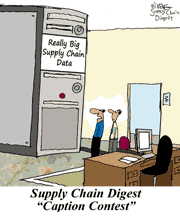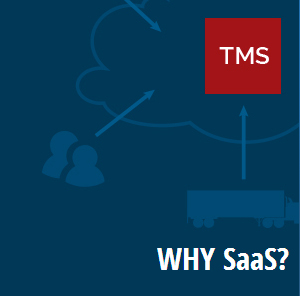 |
June 27, 2014 - Supply Chain Flagship Newsletter |
 |
Second MIT-SCDigest Study on US Manufacturing 2014 Is the Reshoring Trend Real? How has Thinking Changed Since 2012? |
|
|
If you PARTICIPATED and COMPLETED the 2012 Re-shoring Survey: |
 |
|
|
|
 |
|
||||||||||||||||||||||||||||||||||||||||||||||||||||||||||||||||||||||||||||||||||
Insight from the 2014 Gartner Supply Chain Study
|
|||||||||||||||||||||||||||||||||||||||||||||||||||||||||||||||||||||||||||||||||||
| GILMORE SAYS: |
" I believe Cloud will take a bigger share by then, as I have argued in the past. We'll see who is correct." WHAT DO YOU SAY? |
I had to check with Garter analyst Dwight Klappich when he sent me this year's report, done in powerpoint fashion, because it sure didn't look much like the output in previous years. Klappich told me they had tried to make the data presentation more interesting this year, so Gartner changed the style quite a bit, which I think largely worked, though there are a few charts I liked a lot that have simply vanished. Alas. It's still good stuff.
So, I will summarize some highlights from this year's findings.
The research looked once again at obstacles to supply chain success. It is a little hard to say which is exactly seen as the top obstacle, based on the chart below, because you could define it different ways. Current "leadership and corporate culture" had the most votes for the number one barrier, at 18%, while "forecast accuracy and demand variability" receive the highest combined percentage across first, second and the third place, at 45%. That was just ahead of the combined 44% score for the challenge of synchronizing end-to-end processes.
Those three, plus a lack of cross functional collaboration, were all far ahead of the next group of supply chain barriers. For all the concern about supply chain talent, for example, it actually scored very low in the rankings.
In terms of supply chain strategies, Improving supply chain visibility came in at the top, with 84% of respondents rating it as a top supply chain priority. That was followed by "improve business intelligence" (81%), which we can surmise as being connected to the whole advanced analytics movement, and then achieving "integrated business planning," at 74%.
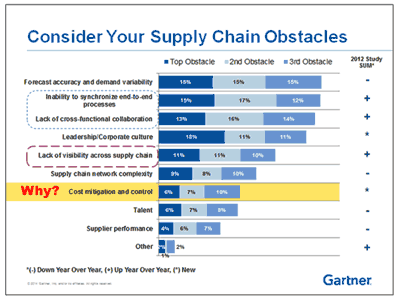
Outsourcing, supply chain segmentation strategies, supplier rationalization and SKU rationalization scored at the lower end of the priority scale, though even those had somewhere near 50% of respondents saying they were important. Supply chain network design, government compliance, and globalization initiatives were in the middle, with about 60% saying they were important.
You have to wonder if a supply chain can really do so many things in parallel, given all these initiatives scored highly. I am tempted to say no, but admit after recently hearing about the rapid and incredibly broad supply chain transformations at 3M and Schneider Electric, maybe this many initiatives can in some cases be pursued in parallel.
One of the most eye-popping charts in the report is provided below, which shows the changes over time to how "strategic" supply chain is considered. As can be seen, the number of companies seeing supply chain as being strategic has risen sharply and consistently, from just 27% in 2009 to 55% in this study.
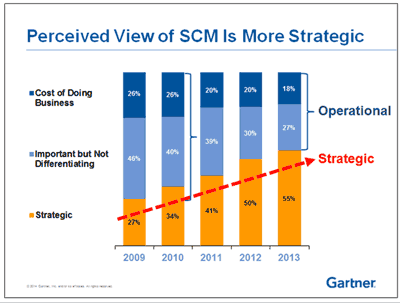
That is quite stunning, and has many ramifications: presumably better representation at the CXO level and perhaps even the board level; more investment dollars; more internal collaboration. I will write more relative to this soon - certainly it has become commonplace today for supply chain initiatives to be cited and discussed in much detail in quarterly earnings releases and analyst conference calls in recent years.
That said, the survey again found that expectations about future budget levels of supply chain investment were substantially higher (23%) for future years (2017) than the current year, which based on past surveys never seems to quite materialize when we get to those future years.
And respondents said that investment to reduce costs was more than twice as high as the spend to "transform" their supply chains. In other words, the tactical continues to outpace the strategic.
But really, rightly or wrongly, most companies make those kind of transformation efforts only once in quite a few years, whereas cost is an on-going pressure. Still, I remember Jake Barr, head of Procter & Gamble's supply chain until he retired last year, once discussing P&G's "continuous supply chain transformation" efforts, and I like that thinking too.
Not surprisingly, companies that say they are "aggressive" in terms of supply chain technology adoption are much more likely to invest to transformation or the strategic versus just to "run the business."
The aggressive companies spend about 20% for strategic efforts, versus about 14% for "mainstream" technology adopters, and just 10% for conservative companies.
And does that approach by aggressive companies pay off? There is no conclusive evidence, but the ratio of aggressive to conservative companies among level 4 respondents was 39 to 18, versus 2 to 69 among the least mature level 1 supply chains. But we need to do more work here.
The study also looked at Cloud-based supply chain applications, and had an interesting insight: the more advanced a company's supply chain is, the more likely it is to have acquired Cloud-based systems.
In fact, as shown below, only 18% of level 1 supply chains (least mature) are using some kind Cloud/SaaS solutions, versus 57% for the most mature level 4 companies. And while Gartner expects strong growth in both "private" and "public" Cloud deployments, it still expects roughly 60% of all supply chain software deals will still be in a traditional license model by 2021, down just a little from today's levels.
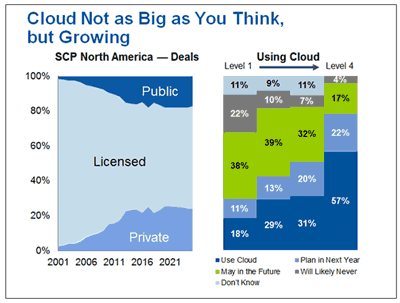
I believe Cloud will take a bigger share by then, as I have argued in the past. We'll see who is correct.
There is a lot more, but think I will wrap it up here. Good research. I might be able to drop you a copy if you send me a note at the Feedback link below.
Hope many of you will support the effort again at the end of the year.
Any reaction to this Gartner Supply Chain Report? Let us know your thoughts at the Feedback section below.
![]()
| View Web/Printable Version of this Column |
|
|
|
YOUR FEEDBACK
Just catching up on some feedback from the past few weeks, including a good analysis of Amazon's reported plans to build its own parcel delivery fleet from Subhash Chowdary of Aankhen.
Feedback on the Amazon's Parcel Fleet Plans:
The "last mile" may not be the accurate term in these new models where the first and last mile is the same; ie. from a local service point in less than a few hours after order placement. This also stretches the concept of a "like" already on its way and delivered at the door step to a user already receiving a delivery. For example lets take grocery deliveries. How many times do we do grocery shopping with lists only to come home and get reminded of the things we missed or should have been on the list? Amazon already knows my 'likes' from the various sources it has. I place an order and then when the delivery is taking place, Some of the items I usually buy are offered as an option. I would like that! There is also another effect of this exercise. The service providers will give Amazon a break on the already discounted cost to retain the business and raise the price on everyone else. The consumer will pay one way or another unless there is a lower total cost alternative. The increase in Prime has already happened once. It is in our own interest that they look at alternatives. Subhash Chowdary |
||
| More on Amazon Plans: | ||
It sure sounds good and certainly "doable" for the likes of Amazon. They just need all those drivers like the rest of us in supply chain transporation. Eugene V. Nusekabel |
||
On a GDP and the Supply Chain: |
||
It is important to understand both the fluffed up components and the reality of GDP, just as it is important to understand the holes in conventional thinking about unemployment numbers. Before we get tangled up in GDP, it might be better to start with understanding the basics of enterprise income statements and balance sheets, and get comfortable with notions such as cash flow, ROA, ROE, ROI, assets, liabilities, and the like. Art van Bodegraven |
||
Thanks to SCDigest for the explanation of GDP calculation and how it connects with the supply chain. You are exactly right - nearly all of us hear and throw out these numbers without really having any understanding of what they mean. I frankly did not connect how much a company's supply chain decisions in the end add up to really impact GDP growth. Thank you.
Alex Wagner Riverside, CA |
||
SUPPLY CHAIN TRIVIA ANSWER
Q: What percent of US retail sales does Walmart have, if you exclude auto and auto part sales, gasoline, and restaurants?
A: About 11.3%, according to SCDigest's unique formula.
| © SupplyChainDigest™ 2003-2014. All Rights Reserved. SupplyChainDigest PO Box 714 Springboro, Ohio 45066 |
POWERED BY: XDIMENSION
|
